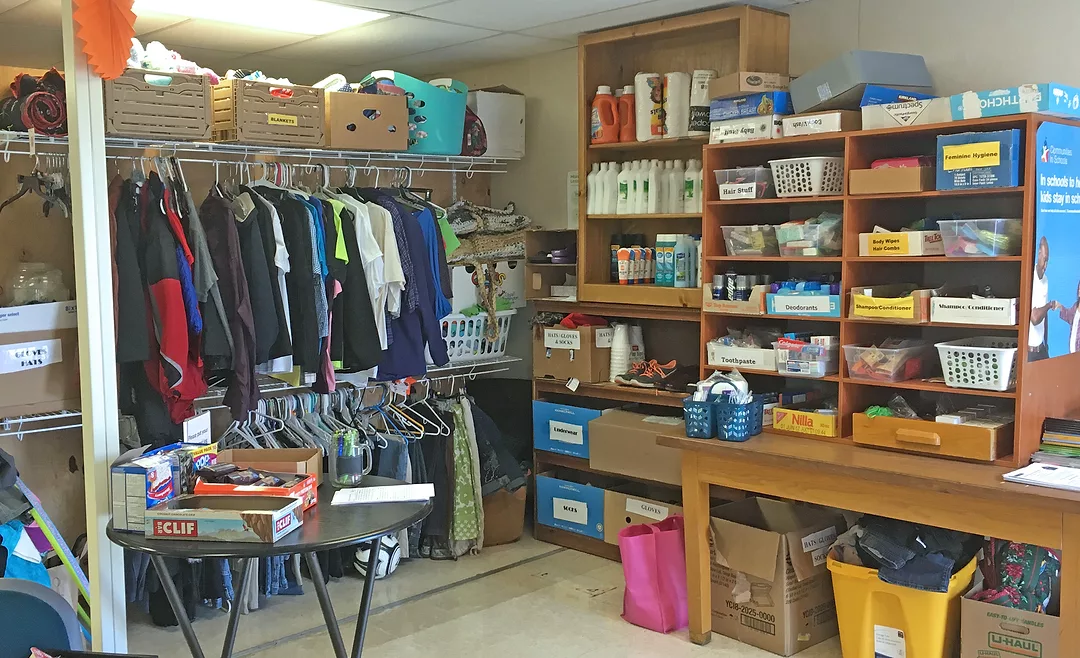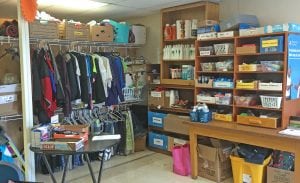
Home » Dropout prevention program expands reach in Tri-City area schools
Dropout prevention program expands reach in Tri-City area schools

September 13, 2018
What causes a kid or teen to drop out of school? The answer to that question can be vast — and attributed to myriad factors, from housing to economic status to food and transportation.
Enter Paulina Valdez, who works for Communities in Schools, or CIS, and has a portable on the River’s Edge High School campus in Richland. CIS is a nonprofit that acts as a connection point for students in Benton and Franklin counties. Each school that partners with CIS has a site coordinator, like Valdez, who has a space similar to a resource room where students can go.
Valdez’s portable on the River’s Edge campus always has an open door. The word “Empower” is taped to it, showing outward to the ball court outside. Inside, a colorful bounty of food, clothes, hygiene supplies and other resources line the walls.
Valdez serves as a connection point for students — all students regardless of socioeconomic status or background —who need anything from a quick snack to help applying for jobs or other services.
“I’m not just the ‘food lady,’ ” Valdez said. “I help with other resources like housing and job search and résumés. We have legal resources and legal connections or basic things like shampoo, conditioner, toothpaste or a toothbrush. And I tell them we’re just the bridge that bridges what they need with the services that are out there.”
At the start of this school year, teachers brought their classrooms out to Valdez’s portable to show them they could visit at any time. Valdez is not a school employee; she works for CIS, a distinction specific to the nonprofit’s model.
CIS is a national organization with county affiliates. The Benton-Franklin CIS serves schools in Richland, Kennewick, Pasco and Prosser.
What started as a small program in a handful of schools in 2014 has exploded. CIS has coordinators in 26 schools across the four school districts this year.
Mark Lee, the development director at Benton-Franklin CIS, said the Benton-Franklin affiliate — one of 12 statewide — is the fastest-growing and now the largest in the state.
Jill Oldson, who serves on the CIS Benton-Franklin board and the Richland School Board, attributes the program’s growth to a model called PowerSchool, which shows attendance and academic records.
“It’s a model that allows you to get data results to stand behind the process we use,” she said. “It’s really nice that they have such a detailed easy-to-use model of how to engage these students because you still get to do it your own way based on your own community.”
Each school that has a CIS coordinator allows them access to PowerSchool data. Valdez can track students’ attendance, grades or behavior as they work through some of the barriers and challenges they face.
 CIS is not so much a service provider as it is a service connector. Valdez said that while she can connect students with immediate needs, like toiletries or coats and shoes during the winter, she said she also reaches out to other community organizations, connecting students to their services. She manages about 32 students at a time, getting consent from their parents if they are younger than 18 years old. Some are homeless.
CIS is not so much a service provider as it is a service connector. Valdez said that while she can connect students with immediate needs, like toiletries or coats and shoes during the winter, she said she also reaches out to other community organizations, connecting students to their services. She manages about 32 students at a time, getting consent from their parents if they are younger than 18 years old. Some are homeless.
“It’s just preparing them for adulthood besides trying to graduate them. It’s not all about graduation,” she said.
The program also can connect students’ families to services. Valdez said she recently helped a mother and a family of six get a housing voucher after finding out they were sleeping in their car at nights to keep the family together.
In the 2016-17 school year, when CIS was in 18 schools, nearly 9,500 students received services, with 585 receiving specific case management. Ninety-seven percent of the high schoolers who received help stayed in school.
The state average graduation rate is nearly 80 percent, according to data from the state Office of the Superintendent of Public Instruction. But this number drops drastically for students who are homeless. Fifty-three percent of homeless students statewide graduated in 2016. The homeless student graduation rate in Prosser and Pasco school districts is 60 percent; it’s 35 percent in Richland and 45 percent in Kennewick.
Oldson said that a few schools in the Richland School District qualify for free- and reduced lunch, which means 60 percent of the students are living near the poverty line. She said many students across all four districts served by CIS are homeless, too.
“It’s our responsibility as community members to make sure that we are having the best interests (in mind) for every student that lives in our community, regardless of the hand that they’ve drawn,” she said. “And I think what we’ve really shown is that we can help them change the cards they’ve been given. They have the power to draw more cards and make a hand that helps them truly succeed in life, and that’s what we all want, at the end of the day, we all want the same things for our kids.”
Currently, CIS coordinators are paid largely with school funds, and the partnership between schools and CIS is dependent on this money. Lee said he is working to increase donations and partnerships to make the program more sustainable.
“We can’t rely on the schools to fund us forever,” he said.
Valdez’s favorite part of her job in almost four years is witnessing “aha” moments.
“(When) the student (thinks), ‘Oh, I have it in me to do that. Like aha, I can do that,’ (they realize) their own motivation because we sit down and set attainable goals,” she said. “Their aha moment is so rewarding to me, I just love that part.”
Communities in Schools Benton-Franklin: bentonfranklin.ciswa.org.
Local News Education & Training
KEYWORDS september 2018




